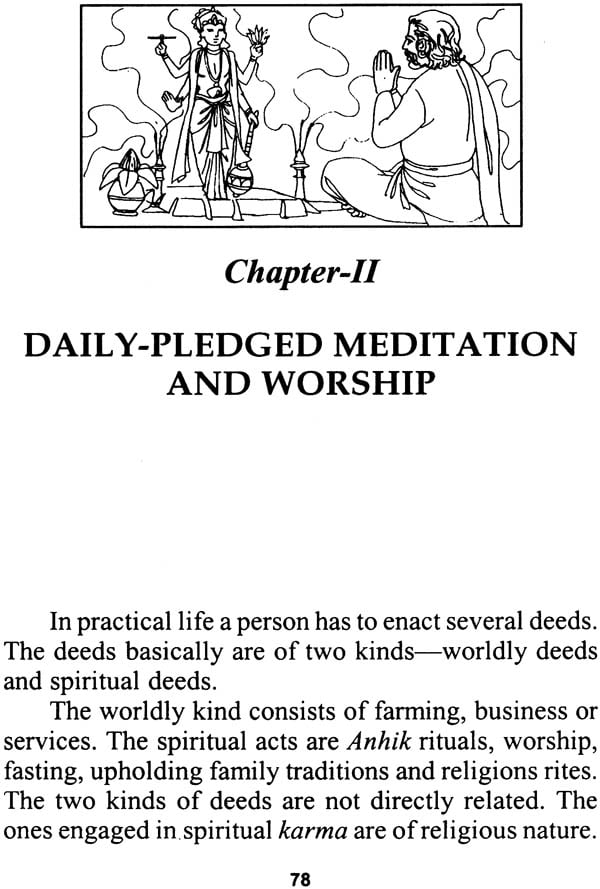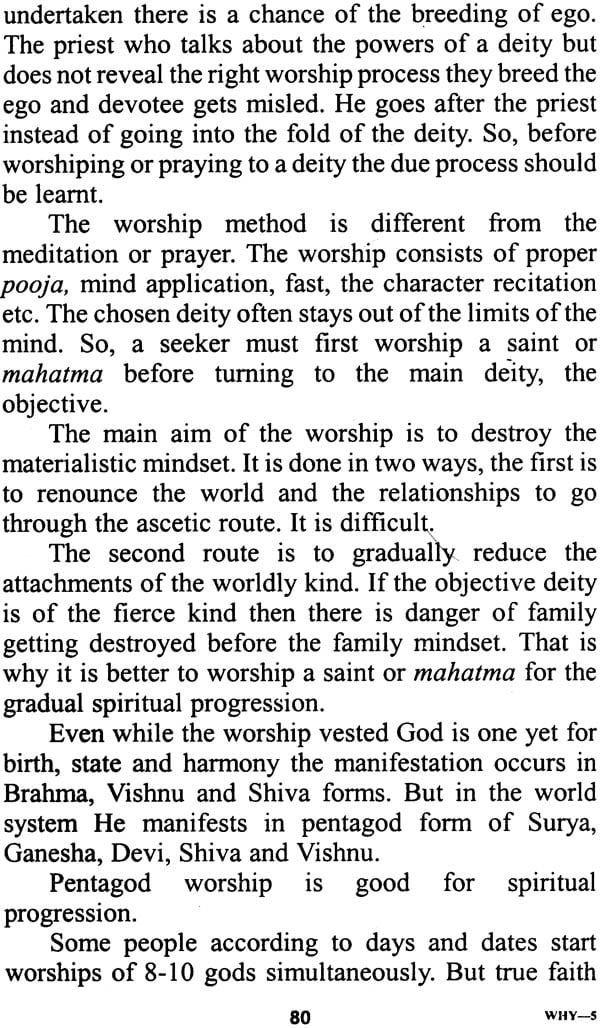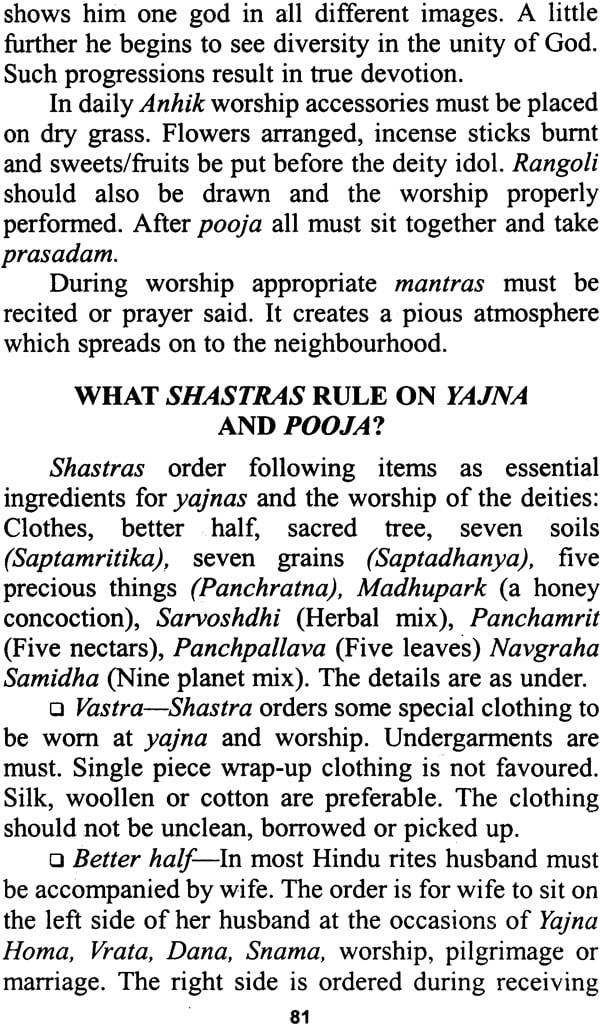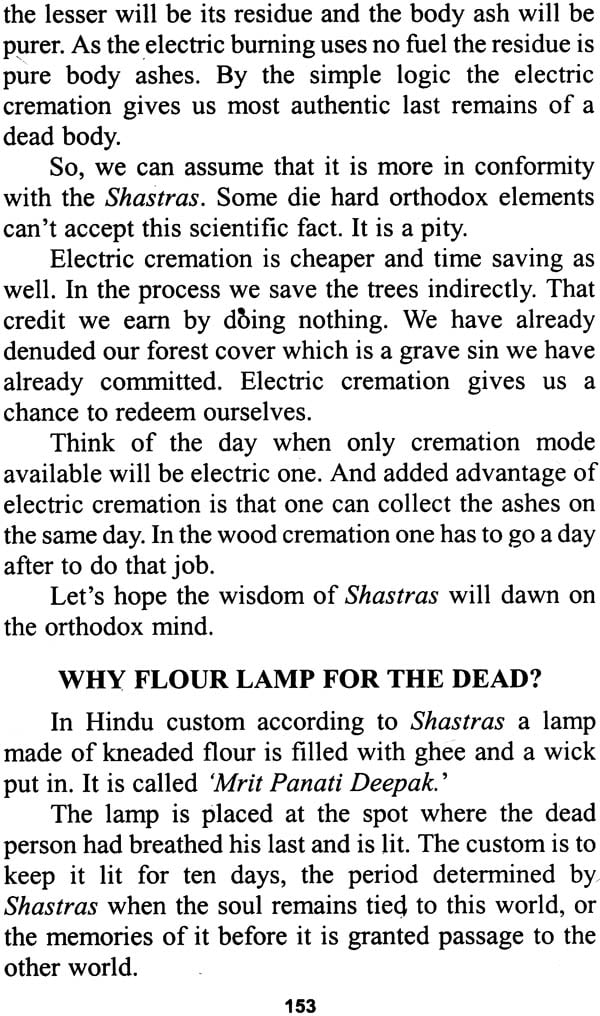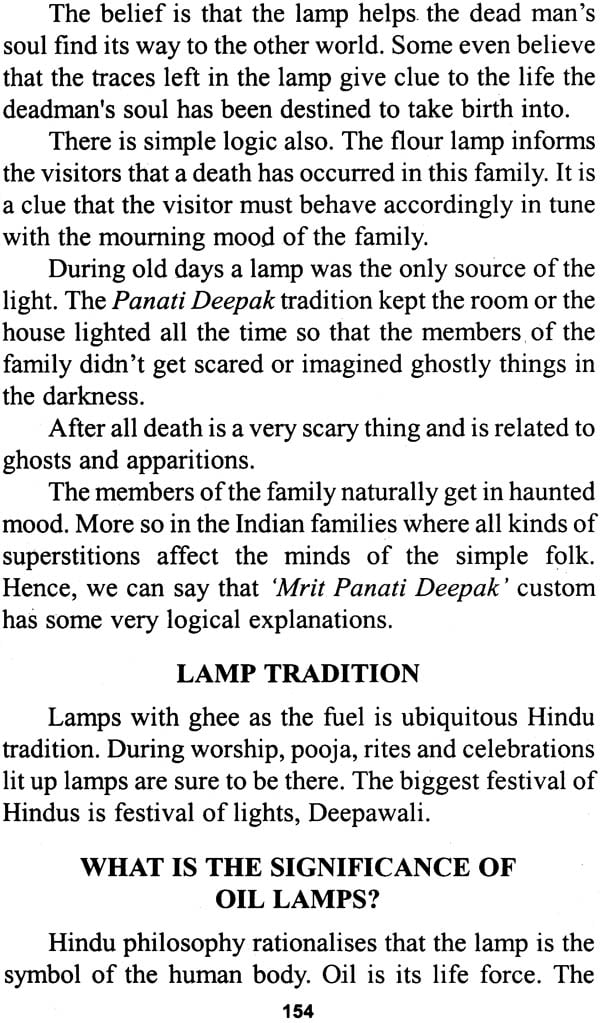
Why? Hindu Customs, Rituals and Rites (The Answer to all the Questions Regarding Hindu Customs and Bliefs)
Book Specification
| Item Code: | IDH314 |
| Author: | Pt. Kisanlal Sharma |
| Publisher: | Manoj Publications, Delhi |
| Language: | English |
| Edition: | 2022 |
| ISBN: | 9788181339935 |
| Pages: | 172 |
| Cover: | Paperback |
| Other Details | 8.5 inch X 5.5 inch |
| Weight | 260 gm |
Book Description
Shastra (or scriptures), the very word brings to our mind the three concepts. The first concept is about Dharma, the religious duty. The second is knowledge and the third is social code. The Shastra is the amalgam of all three having the Dharma as the basic ingredient.
Dharma Shastras are the codified sum total of the wisdom and knowledge culled from the analytical and thinking brains of great sages and scholars of the era of pure nature before the evolution of the culture of the synthetic improvisation. It was the first attempt to explore the truth. So, Dharma Shastra is science, the original scientific endeavour. It also defines the rulers and the ruled besides ordering social codes of conduct. Dharma Shastra thus, is also a constitution.
A constitution and the penal code, although is in elaborate written form yet it requires experts and lawyers to interpret various clauses, provisos and stipulations for the practical application of the laws. And the judge is expected to hear the interpretations and give verdict using his own impartial conclusions. Similarly Dharma Shastra needs scholars and appointed professionals to interpret its provisions. The laws undergo constant changes through amendments to remain in tune with the ever changing situations and conditions. Dharma Shastra faces the same challenge. So, it also justifies and accepts newer interpretations of its sutras (clauses) to meet the demands of contemporary political and social realities.
The changes in Shastra in itself is a law or a definite process. Systematic criss-cross patterns of threads weave a cloth. Similarly Shastra is woven by threads of constant, variable and period values of mankind. The constants are there eternally in set pattern. They don't change. But the variable and period values go on changing according to the situation. In Shastra format yajnas, charity, penance, karma, learning etc. are constant values. But the form and the process of their applications are subject to changes.
In ancient times for learning a student was required to go and live with the teacher. In Middle ages schools, universities and hostels came up. In modem age the learning is carried through primary, middle, high, college and post graduate education systems. Similar is the case with yajna, charity, penance, karma etc. As constant values they are eternal. Only the process can change. Sometimes changes are accommodated by expansion or extension of the meaning of sutras, for example, the extended meaning to yajna given by Lord Krishna in Gita allows us to take even the modem act of dieting also as a yajna because here a person through that act is burning the possibility of unwanted fat in the fire of dietary austerity. But often the constant values have been shifted to serve the cause of some vested interest. It led to the bastardisation of Shastra giving birth to corrupt sects.
The shallow knowledge of Shastra resulted in the people individually or collectively committing excesses in yajna, karma, sacrifice, spiritualism etc. for selfish motives. So to fight such corrupt tendencies sages have taken birth from time to time. To cleanse the society they preached corrective values and their thoughts evolved into new religions that attracted good numbers of followers because of their reformist values. But over the period of time they degenerated because they were not built upon the foundations of the constant values.
Those new messiahs took their followers into the shining path that actually led to a dark tunnel of confusions. Consequently the society paid the price. Some of the intelligent followers realised the mistake but there was no way for them to redeem the situation. Dharma Shastra has introduced several customs and traditions inadvertently that proved harmful in the long run. Some who knew it could not summon courage or found support to change them. Social reformers blindly attack those customs and traditions hurting in the process the constant values, faith and the very elemental noble principles. They do more damage than good.
Thus, for a long time man has suffered the materialistic and selfish systems. So, as advised in Gita, it is time for introspection. The introspection reveals the distortions created by induction of wrong traditions and social evils in the variable or period values overlapping the fundamental and universal constant principles. It is essential to understand the forms of constant and variable values.
For example, a man and a woman tie the knot in traditional ceremony ordered by the Shastra to empower the marriage institution for the creation of a civilised society. It is an essential constant value. Regional marriage customs represent variable values. When these customs are logical, pious, good intentioned and noble then both the values are in harmony and the Shastra so created works in the benefit of the society. Today our society needs the creations of an honest Shastras which retain the basic elements of faith and sublime constant values in such a way that it fits into the parameters of the laws of physical science and the modem realities. Such a Shastra should lead to the composite progress of the human society.
The ignorance of constant and variable values result in erroneous distortions and degenerations. These distortions carried through by generations become traditions which in turn earn the respect of being tested values solemnised by time. That makes them look like authentic parts of the Shastra and the society suffers from irreparable damages. Such a corrupted society degenerates in thought and deed.
The distorted customs and traditions eat into the vitals of the social values like viruses which can only be destroyed by the modem education used as antibiotic. Such customs carried forward by blind faith when reach the untenable limits then we think of putting them to scientific test. But in doing so social science, psychology and para-science must also be taken into consideration and given due weightage. The intelligentsia and logical minded religious scholars are trying to correct the distortions in the religion with the help of all the scientific testing grounds. In such a back ground is this analysis and the conclusions based.
Shastra is not taken here in the narrow religious sense but it encompasses wider social implications, civilisation, mass traditions, customs and general practices. Because a Shastra is shaped by various processes at different times. A person's habit or style might be copied by the members of his family and it can evolve as a family trait. The same trait when accepted as a fashion by others becomes a custom of that group. Its wider acceptance makes it a social tradition.
When the tradition is recognised by the intelligentsia, thinkers and the paragons of the society as a trade mark it becomes one of the features of that civilisation. These features change according to social, cultural and topographic environments. Especially time wise when a period provides distinct standard of living. When social science, psychology and para- science are in agreement with the tradition it becomes a religious custom. When the custom is positive for the culture and religious traditions it automatically becomes a religious order. These orders when pass the test of the. scientific logic they become standard yardsticks. Such yardsticks are compiled as sutras to become Dharma Shastra.
The close study of the process of the evolution of Shastras reveal that the constant values do not change. Only the variable and period values keep undergoing changes. In such a scenario Shastras can only be created by determining the constants and the variables. Keeping the variable values in view the Shastra creators keep a lot of provisions, exceptions and conditions appended to sutras. For example, a woman in her period can't do any religious work but on eclipse day she can do worship after a bath. In illness or love sickness the bath is forbidden. Just as amendments are drawn when an Act is passed to deal with the new situations, similarly when a Shastra rule is followed the sub-rules that have to be kept in mind.
One must follow Shastras only after studying rules, sub-rules, exceptions, conditions and provisions to get full benefits in this world and the other. Without the provisions for penance and reliefs the entire Shastras would become a misconduct. The society would be crushed between dogmatism and the guilt of misconduct. So, the reliefs of the penance and provisions provided by the Shastras must be judiciously used and the benefits reaped.
But indiscriminate provisions, exceptions and conditions weaken the foundations of Shastras.
Many a time the penances and the reliefs are not granted by Shastras but are introduced by unholy elements for vested interests. It creates very unsavoury situations and brings a bad name to the religion. Suppose a Shastra prescribes a penance or a worship or fast for a sin and the interpreter adds to it some provision of his own to derive material benefit for himself then the Shastra looks like a fraud and the thinking people begin to hate it.
Sanatana Hindu Dharma is not only about Karma theory but it preaches spiritualism and four pronged endeavours namely Dharma, Artha, Kama, and Moksha. That is why the creation of Dharma according to periods underwent period evolutions. At the times of changes in the culture and the society human character also evolved elements of the development. But due to several reasons this evolution got narrowed down to Karma of valueless kind. Karma degenerated into the end game from being the means for sublime goals.
Karma is manual input for purification of mind. The people forgot it. The thinking that life was for Karma distorted Karma into the means of ego boosting. It proved a road block in the path of spiritual development. Whenever such degeneration led to the stage where society seemed lost in purposelessness and on the verge of disintegration some saint arrived on the scene to redeem the mankind and save the situation. Gyaneshwara, Tukaram, Ramdas, Kabeer and Guru Nanak are the stellar examples. The degeneration got a check. The people realised that Karma was meant for the purification of the mind. The relevant changes were introduced into Shastra accordingly.
Infact we can not ignore the psychological impacts of thoughts on individual and collective levels. Often there is a great chasm between the individual and social mindsets which can only be filled with pious religious conduct. Pious thoughts give shape to the desired mindset. It begins to understand the good and the bad eIements of life and beyond. So, Shastras set separate rules for different types of mindsets. Several fasts are prescribed for the collective keeping in the fashion of a public ceremony.
|
CHAPTER - I: DAILY CONDUCT (ANHIK)
| 25 |
| WHY GET UP IN BRAHM MUHURTAM? | 28 |
| WHY STICK TO DAILY ROUTINE? | 28 |
| WHY RECITATION IN THE MORNING? | 30 |
| WHY LOOK AT PALMS IN THE MORN? | 32 |
| WHY THE PROVISION OF AUSPICIOUS SIGHTING? | 32 |
| WHY SYMBOLIC BATH? | 33 |
| WHY YELLOW ROBES FOR RELIGIOUS CONDUCTS? | 34 |
| WHY GOLD-SILVER WARE FOR RELIGIOUS CUSTOMS? | 35 |
| WHY GO AROUND DEITY IDOLS? | 37 |
| WHY SIT ON GRASS MAT? | 38 |
| WHY TILAK ON FOREHEAD? | 39 |
| WHY SPECIAL MATS FOR RITES? | 40 |
| WHY KEEP SHIKHA (SKULL-TOP HAIR LOCK)? | 41 |
| WHY WEAR JANEOO (SACRED THREAD)? | 43 |
| WHY DIFFERENT DIRECTIONS FOR DIFFERENT RITES? | 45 |
| THE DIRECTIONS-GOOD OR BAD? | 47 |
| WHY DRINK WATER IN SMALL MEASURES? | 48 |
| WHY PRANAYAMA? | 50 |
| WHAT IS SANKALPA? | 51 |
| RELIGIOUS SANKALPA TYPES | 53 |
| WHY CHANT ON STRINGED BEADS? | 53 |
| WHY 108 BEADS IN A MALA? | 55 |
| EXCEPTIONS | 56 |
| WHY CHANT ON MALA? | 56 |
| WHY EVENING PRAYER? | 58 |
| SANDHYA NORMS | 59 |
| WHY PROVISION OF PANCHAMAHAYAJNA ? | 59 |
| WHY INVOKE 'SWAHA' DURING YAJNA OFFERING? | 61 |
| WHY WORSHIP YANTRA? | 62 |
| WHY SHRIYANTRA IS THE GREATEST? | 62 |
| WHY KEEP SILENCE (MAUN-VRATA)? | 63 |
| WHY BELLS ARE RUNG IN TEMPLES? | 65 |
| WHY CELIBACY? | 67 |
| WHY AVOID ALIEN FOOD? | 69 |
| WHY NOT READ IN LYING POSITION? | 70 |
| WHY IS FLESH EATING BAD? | 71 |
| WHY ONION AND GARLIC ARE NO GOOD? | 73 |
| WHY TOUCH BELLY AFTER EATING? | 75 |
| WH 100 PACES TO DIGESTION? | 75 |
| WHY SLEEP ON THE LEFT SIDE? | 76 |
| WHY PROPRIETY? | 76 |
|
CHAPTER - II: DAILY -PLEDGED MEDITATION AND WORSHIP
| |
| WHAT SHASTRAS RULE ON YAJNA AND POOJA? | 81 |
| WHY IDOL WORSHIP? | 83 |
| WHY DO IDOL WORSHIP, SYMBOLIC WORSHIP, ABSTRACT WORSHIP AND SPIRITUAL WORSHIP? | 84 |
| WHY A BHISHEKM (ANOINTMENT)? | 85 |
| ANOINTING PROCESS | 86 |
| WHY FLOWERS ARE OFFERED TO GOD? | 87 |
| WHY LOTUS IS IMPORTANT? | 89 |
| WHY SOUND CONCH SHELL? | 90 |
| WHY MOVE ANTI-CLOCKWISE? | 91 |
| WHY GREET WITH FOLDED HANDS? | 92 |
| WHY PANCHAMRITA? | 94 |
| WHY PRASADAM? | 95 |
| WHY NAIVAIDYA (FOOD OFFERING)? | 96 |
| WHY CONSIGN IDOLS TO WATERS? | 96 |
| WHAT IS SPECIAL ABOUT SHIVA POOJA? | 99 |
| WHY SHIVA WORSHIP AT NIGHT? | 100 |
| WHY FAST AND JAGRANA ON MAHASHIVARATRI? | 101 |
| WHY SHOULD WOMEN RECITE VEDIC MANTRAS? | 102 |
| WHY 'OM' IS SO SIGNIFICANT? | 104 |
| WHY CHANT MANTRAS? | 107 |
| WHY WORSHIP GURU ALONG SIDE DEITY? | 110 |
| WHY PAY GURU DAKSHINA? | 111 |
| WHY MAKE A WISH? | 111 |
| WHY WE NEED GOD'S MERCY? | 114 |
| WHY RELIGIOUS RITES AND CUSTOMS ARE DIFFERENT? | 115 |
| WHAT IS RUDRAKSHA? | 116 |
| WHAT'S MEDITATION? | 117 |
|
CHAPTER-III: PERIODIC FASTS-FESTIVALS
| 118 |
| HOW DO WOMEN RETAIN SANITY? | 120 |
| WHY KEEP FASTS? | 120 |
| WHY WORSHIP VIRGIN GIRL? | 122 |
| KAALI MA | 123 |
| WHY CONSIGN GANAPATI IDOL TO WATERS? | 124 |
| WHY WISH UPON A BANYAN? | 125 |
| WHY VISHNU IN THE SEA OF MILK? | 126 |
| WHY DOES LAXMI PRESS THE FEET OF VISHNU? | 127 |
| WHY LAXMI RIDES AN OWL? | 128 |
| WHY ANIMAL INCARNATIONS? | 129 |
| WHY NOT VIEW MOON ON CHATURTHf? | 131 |
| WHY AVOID EATING DURING ECLIPSE? | 132 |
| WHY IS TULSI GOOD? | 133 |
| WHY PEEPAL TREE IS WORSHIPABLE? | 134 |
| WHY SWASTIKA IS HOLY SIGN? | 135 |
| CHAPTER - IV: TRADITIONS & CUSTOMS
| 137 |
| WHY CASTE SYSTEMS? | 139 |
| WHY CO-GOTRA MARRIAGES ARE FORBIDDEN? | 142 |
| WHY TIE KNOT IN MARRIAGE? | 142 |
| WHY SEVEN ROUNDS AROUND FIRE? | 143 |
| WHY MARRIED WOMEN APPLY VERMILLION? | 144 |
| WHY SHOULD A WIFE WEAR MANGALSUTRA? | 146 |
| WHY MARRIAGE RITUALS? | 148 |
| WHY SO MUCH BOTHER? | 148 |
| WHY VANPRASTHA? | 149 |
|
CHAPTER-V: LAST RITES-SHRADDHA IMPIETY PERIODS
| 151 |
| WHY ELECTRIC CREMATION IS OKAY? | 152 |
| WHY FLOUR LAMP FOR THE DEAD? | 153 |
| LAMP TRADITION | 154 |
| WHAT IS THE SIGNIFICANCE OF OIL LAMPS? | 154 |
| WHY KAPAALKRIYA? | 155 |
| MISCONCEPTIONS | 156 |
| WHY OBSERVE DASWAN(TENTH DAY)? | 156 |
| WHY ONE YEAR MOURNING PERIOD? | 157 |
| WHY SHRADDHAS OF DEAD ONES? | 157 |
| WHY SHRADDHA ON AMAVASYAS? | 158 |
| WHY THE RITUALS? | 159 |
| WHY OFFER WATER TO SUN? | 160 |
| FOR MISSING PERSONS | 162 |
| WHY IMPURITY PERIODS-ASHAUCH? | 162 |
| WHY MATERNITY UNTOUCHABILITY. | 163 |
| WHAT IS THE LOGIC BEHIND THIS? | 164 |
| WHY DEATH UNTOUCHABILITY? | 165 |
| WHY WOMEN IN PERIODS ARE UNTOUCHABLE? | 165 |
| APPENDIX
| 167 |
| WHY WATER IS OFFERED TO SUN? | 167 |
| WHY GANGA WATER IS SACRED? | 168 |
| WHY KALASHA IS SIGN OF GOOD? | 168 |
| WHY SHANI IDOL IS OINTED WITH OIL? | 169 |
| WHY RED VERMILLION FOR HANUMANA? | 171 |
| WHY FIVE GREEN PILLARS IN A WEDDING? | 171 |
| WHY MUNDANA? | 172 |
| WHY MOON WORSHIP ONKARVA CHAUTH? | 173 |
